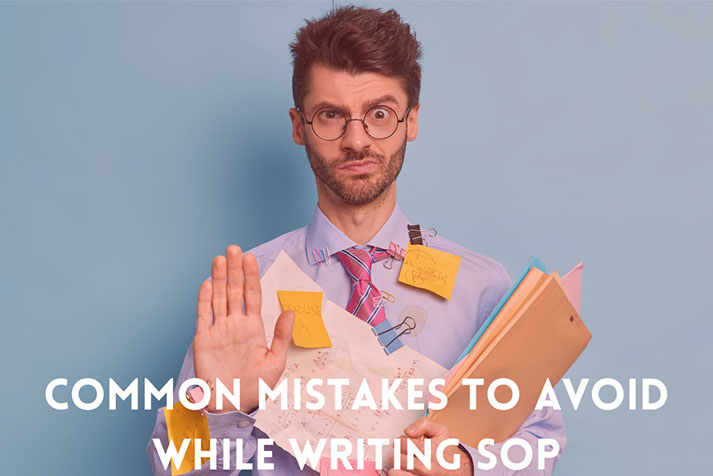03 Jun Common Mistakes to Avoid while writing Statement of Purpose

SOP is an abbreviation for Statement of Purpose, which is essentially an academic essay that should also include the reason for adapting to a specific course or college. Statement of Purpose is a crucial document that is needed by all foreign colleges. Your SOP should prove why you want to study abroad. The purpose statement is defined in section layout and follows the basic essay writing guidelines. There are some common SOP mistakes to avoid to prevent rejection.
A normal Statement of Purpose is typically 800-1000 words and two pages long. It has a maximum font size of 12 points and is double positioned with normal edges. When writing the SOP, the applicant should keep in mind that no vibrant colors, captions, or photos should be used, and that it should only be documented in black and white.
Common SOP Mistakes to Avoid to Prevent from Rejection:
- Dull Introduction: This is the most common SOP writing mistake that an individual makes while preparing the statement of purpose. When writing an introduction, an applicant should take into account that it is the foremost important thing that will be scanned. Because the first impression is always the last impression, you should always construct an appealing introduction that will draw and keep the reader’s interest in order to gain a priority. Try to start your text with a solid line that highlights your academics, motivations, self-belief, and great personality.
- Excessive discussion of your childhood fantasy: When constructing your Statement of Purpose, keep in mind that foreign universities want applicants who are accurate, concentrated, and profound about their career choices. You should come across as a performer and a focused individual rather than a dreamer. Keep in mind that your childhood fantasies will guide your subject selection in the 11th and 12th grades, but not later in life. You should really be specific if you’re going to discuss how your childhood fantasies influenced your decision to pursue a career.
- Started writing at the last second: This is the most common SOP writing mistake that applicants should avoid. Applicants should keep in mind that students who wish to study abroad must submit a Statement of Purpose to their colleges. The most usual error in constructing Statement of Purpose is doing so at the last second or simply copying it from one of the many SOP samples available on the internet. These common blunders must be overlooked by applicants if they are to pique the interest of the readers. An applicant must begin writing his or her Statement of Purpose at most 30 days before submitting it to the different colleges. You should always open for areas that need improvement, and drafting it at the last moment will not provide you sufficient hours to do so.
- Failure to write within the needed word count: The word count for writing a Statement of Purpose is generally set by the college. However, if the college has not specified a word limit, you should always ask the college’s admissions office to learn more about word count. If you are unable to obtain information about the word count for any reason, you should try documenting your Statement of Purpose between 800-1000 words. Applicants should never surpass the word limit because he/she must acknowledge the time period of the authorities who are checking their SOP’s. Because there must be a large number of candidates registering to the same course and college, the authorities must go through each SOP, so you should always adhere to the word count.
- Using an Indirect Writing Style: Using indirect language in your SOP is a bad idea, and it may result in your admission to your preferred college being denied. While writing their SOPs, applicants should use a systematic and professional writing style. When writing SOP, they should be polite and courteous. Your essay should be clear and concise. Make sure that you do not use any notations or slang in your SOP.
- Being vibrant: Your composition, as well as the typography you use, should be simple and unobtrusive. It is very important to compose about your accomplishments and great educational record, but keep in mind that it will be better if you don’t seem arrogant and conceited about it. A candidate’s body language and personality should be sincere and friendly. Furthermore, an applicant should be keen and interested in learning at all times. Aside from using polite words, the applicant should also use a good font. The applicant must not use fonts that are bold, italics, vibrant colors, or underlined. When writing the SOP, the applicant should use a simple black font.
- Overly Generous: You should not use a lot of words to praise the college or the teaching staff. Keep in mind that your aim should be to demonstrate why you and the college are inclusive, not to demonstrate why the college is the best. Complimenting more about the university will make you look like you’re constantly striving and may come across as fake. Being truthful is essential here; if you truly love something about the college, you should indicate it while remaining concise and accurate.
- Proofreading: This is always a good idea after writing any kind of composition. After you have finished writing your SOP content, you should check it carefully at most 2 times to ensure that there are no grammatical, vocabulary, punctuation, or other silly errors. If you finalize your Statement of Purpose with any errors, it will portray a negative image of you and could be a main reason for you not being admitted to your preferred university, as expertise in the English language is a prerequisite for studying abroad.
In a nutshell, considering professional SOP writing services in Delhi is the solution to avoid all the above common SOP mistakes.
What not to include in SOP?
Many times, even if your Statement of Purpose is grammatically correct, it is rejected because it is too long. SOP is a vital document that plays a significant role in deciding your achievements in gaining admission to the preferred university or job. As a result, while you must mention every accomplishment you have made, you must also strike the right balance between them. Thus, you have to be very precise and avoid all such common SOP writing mistakes.
You may decide not to mention certain accomplishments, or you may choose to consider them briefly, or you may choose to illustrate others. You must understand what should not be included in a SOP and how to strike a balance between the different attributes.
Common SOP Mistakes that lead to Rejection:
Don’t Provide the Wrong Information in the Document
The admissions committee wants you to submit documentation that is entirely accurate, therefore you must provide evidence of every activity from your academics to your leisure activities. If you are unable to provide them with the required proof of our efforts, such as academic transcripts and participation credentials for all activities completed, the authorities will see you as a mistake and reject our proposal.
Do Not Copy Your SOP from the Internet
In colleges and universities throughout the world, plagiarism is a major concern. Never steal any of the Sample SOPs, Sample Essays, or ex-applicant papers from the Internet. A foreign university’s immediate rejection of your application, as well as a permanent blacklisting, may result if you submit plagiarized or copied documents. Always write your essay/SOP from start to finish on your own. If you’re having trouble coming up with a suitable statement of purpose, do some research and get some ideas.
How to make your SOP Distinctive?
SOP writing has many essentials that will help you better understand what you need to remember, such as the general word limit, framework, and so on. What’s important to remember is that you must always remember which degree program you’re writing the SOP for. Make sure you don’t leave anything out and that you don’t dwell on the other stuff too much. The SOP for an MBA application will be very different from the SOP for a Masters proposal. Similarly, the SOP for a Bachelor’s degree program would differ greatly from either of the two.
Conclusion
Whether you are applying for undergraduate, graduate, or postgraduate programmes, keeping focus throughout is the best way to write a strong statement of purpose or SOP. You must cautiously join the dots between achieving your goals and your school and course options, starting with your academic or professional background and ending with your career opportunities.
The essay should flow smoothly from start to finish, covering your prior experience, recent activities, and future goals. One thing to remember when writing your SOP is to divide it into parts that cover all of the points of interest. To achieve the best out of your SOP, you must consider professional and experienced SOP writers in Delhi.


No Comments